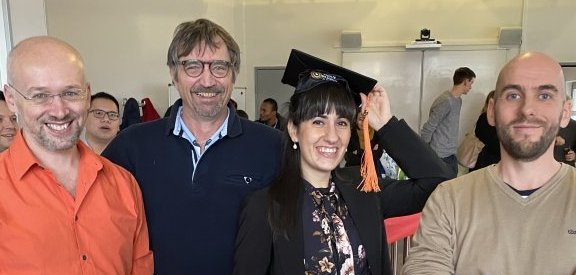Sous réserve de la délivrance de l’autorisation de soutenance :
Maria Roberta Longhitano defends his PhD on Dec. 18, 2019 at 02:30 PM.
Place : Ecole Centrale de Lyon, Bâtiment W1, Amphi 201.
Jury :
Rapporteurs :
Mme Ruth Vazquez Sabariego, Professeure, KUL, Leuven, Belgique
M. Ermanno Cardelli, Professore, Univ. degli Studi di Perugia
Autres membres :
M. Laurent Daniel, Professeur, Centrale Supélec, Laboratoire GEEPS, Gif sur Yvette CEDEX
M. Christophe Geuzaine, Professeur, Univ. de Liège, Belgique
M. Riccardo Scorretti, CR CNRS, ECL, Laboratoire Ampère
M. Laurent Krähenbühl, DR CNRS, ECL, Laboratoire Ampère
Invités :
M. François Henrotte, Assistant de recherche et chargé de cours, UCLouvain, Belgique
M. Fabien Sixdenier, MCF HDR, UCB Lyon 1, Laboratoire Ampère
 Abstract :
Abstract :
Magnetic materials play a central role in electromagnetic energy conversion applications. The actual trend of power electronics is to stress these materials at higher temperatures and higher frequencies. Therefore from engineer’s point of view it is crucial to have reliable and accurate models able to predict the behaviour of such materials at various temperatures.
This thesis is devoted to the modeling of static hysteresis in magnetic materials by using Henrotte’s energy-based model which, among other nice features, is inherently vectorial. In particular, three points are highlighted: 1) the characterization of the model from experimental data, 2) the usage of this model in a Finite Element softer to simulate electrical devices, 3) the influence of the temperature on the material.
A large number of measurements have been executed by using original experimental setups. Measurements have been performed at different temperatures (spanning from 223 K to 448 K) and for several excitation signals. By using these measurements, an original model of a 3C90 soft ferrite which takes into account the temperature has been found. In particular, we propose a scaling law which allows to predict the behaviour of the material at different temperatures. The approaches developed in this thesis allowed to take into account the effects of temperatures with success, i.e. the accuracy is satisfying on all the temperature range with a same number of parameters. This model has been validated by using uniaxial excitation with simple and complex signals. A benchmark to check the capability of our model to take into account vectorial excitation has been developed. This benchmark, which consists in a three-leg transformer excited by two coils with independent voltage sources, has been designed, manufactured and simulated in 2D by using the Finite Element software Gmsh/GetDP. Experimental measurements and numerical simulation are reasonably close, and demonstrate the reliability of our modeling. Starting from these results, future developments can be foreseen. In particular, two points of paramount interest are the extension of the model to be able to work at higher frequencies and the link between the micro-structure of the material and the properties of our model.

Vidéo ici.
Key Words :
View online : Texte complet


